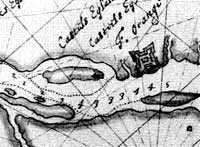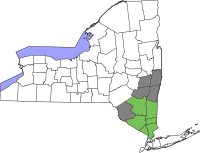Fort Orange (New Netherland)
Fort Orange Archeological Site | |
 Fort Orange in c1630 (Rensselaerswyck map detail) | |
| Location | Albany, New York |
|---|---|
| Coordinates | 42°38′41.46″N 73°45′1.05″W / 42.6448500°N 73.7502917°W |
| Built | 1624 |
| NRHP reference No. | 93001620 |
| Significant dates | |
| Added to NRHP | November 4, 1993 |
| Designated NHL | November 4, 1993 |
| New Netherland series |
|---|
| Exploration |
| Fortifications: |
|
| Settlements: |
|
| The Patroon System |
|
| People of New Netherland |
| Flushing Remonstrance |
 |
Fort Orange (
History


In 1624, a ship with 30 Protestant Walloons (people from what is today southern Belgium) landed in New Netherland; 18 of the men were sent to the location near present-day Albany. Under direction of the Dutch, they built Fort Orange roughly 2 miles (3.2 km) north of Fort Nassau, which was prone to flooding, and about five miles south of the confluence of the Mohawk River and the North River.[2]
The Walloons were later recalled south to settle
Whereas later settlement would be through the purchase of land from the Native Americans, the Dutch built Fort Orange without any consent. They continued to hold it only through the goodwill of the Mahican, and the occasional presents that they gave to the local Mahicans.[citation needed]
When the Dutch established the
In 1630, Gillis Hoosett purchased in van Rensselaer's name the lands to the south and north of the fort from the natives. Later in 1630 the first permanent Dutch settlers and farmers came to Fort Orange and settled on the outskirts of the fort; their village was first called the Fuyck and later
In 1648, dispute arose between agents of the
After the yearly freshets had damaged much of the fort, the West India Company decided to reconstruct the fort using stone. In response, van Schlechtenhorst declared it illegal for anyone to quarry stone within Rensselaerswyck for the fort or for anyone to sell the material to the fort's commander, Carl van Brugge. All material for the fort had to be shipped in from outside the colony. Van Schlechtenhorst claimed that Fort Orange had been illegally built on the patroon's lands, while Stuyvesant noted that Fort Orange had been built 15 years prior to the establishment of Rensselaerswyck.
In 1651, Stuyvesant declared the jurisdiction of the fort to extend 600 paces around the fort, thereby severing it from Rensselaerswyck; he appointed Johannes Dyckman as commissary of Fort Orange. In 1652, Stuyvesant, to settle this dispute once and for all, set up a "Court of Justice for the Village of Beverwyck and its dependencies", the first municipal government for the future city of Albany.[1][5]
At the time when Beverwyck consisted of roughly 100 structures huddled next to the fort, Stuyvesant set up Beverwyck at a safer distance from the cannons of the fort and laid out future Albany's oldest streets- State Street and Broadway.[6]
By the end of the 1650s, the fort was in disrepair again,[7] and both Fort Orange and Beverwyck were enclosed by a wooden stockade in 1660.[8]
In 1663,
It was not until September 24, 1664, that vice-director of New Netherland Johannes de Montagne surrendered the fort to the English, and Colonel George Cartwright took command. On the 25th, Captain John Manning was given control of the fort, which was renamed Fort Albany; Beverwyck was named Albany.[n 1]
In 1673 the Dutch retook New York City, which they named New Orange, on July 29, then retook Albany on August 3. In September, Albany was renamed Willemstadt and Fort Albany became Fort Nassau. The Treaty of Westminster, signed on February 19, 1674, renamed New Orange and Willemstadt back to their English names; Fort Nassau became Fort Albany and Willemstadt became Albany.[3]
In 1666, Jeremias van Rensselaer, then-patroon of Rensselaerswyck, had petitioned the new government of Governor Nicholls to recognize Fort Albany (Fort Orange) as part of Rensselaerswyck. Governor Nicholls informed him that he would be wise to drop the matter until he heard from the Duke of York. In 1678, Governor Andros issued to the patroon's heirs a grant reaffirming the patroon's rights over Rensselaerswyck, but leaving out Fort Albany and the immediate area around the fort.[3]
The English abandoned Fort Orange and built a new fort on top of State Street Hill named Fort Frederick; it served both to defend the settlement from the Mohawk and other Iroquois to the west and to be on high ground to remind the Dutch inhabitants of English rule. The land around the old fort was sold to the Dutch Reformed Church for use as pastureland, but the fort structure continued to deteriorate. It was indicated on maps during the 18th century, labeled as "ruins of an Old Fort." Richard Smith, a traveler, observed by 1769 that there was "nothing to be seen of Fort Orange... but the Ditch which surrounded it".[7] After the American Revolutionary War, the deteriorated site of the old fort was memorialized as a historic site and was the site of many historical observances.[6]
Subsequent occupation
Simeon De Witt built a large house or mansion and a number of outbuildings on the site of the old fort during the 1790s; the address for the site of the old fort became 549 South Market Street (later Broadway).[7][12] On his property traces of the old fort could still be seen as late as 1812.[6] He lived at this location while he was the surveyor-general of New York.[12] Following his death, his mansion and outbuildings were adapted for use as the Fort Orange Hotel. It burned down in 1848 but was rebuilt under the same name.[7]
In 1886, as part of the bicentennial of Albany's incorporating document, the
As the Fort Orange Archeological Site, the area of the fort was declared a National Historic Landmark (and added to the National Register of Historic Places) on November 4, 1993.[13]
Commanders of the fort
- Adriaen Jorrissen Thienpont[14][15]
- Daniel van Krieckebeck ("Crieckenbeeck ... killed by Mohawks in 1626"[16])
- Bastiaen Jansz Krol ("appointed commissary of Fort Orange several months ... after ... was killed by Mohawks in 1626"; "Krol returned to the Netherlands in 1629"[16])
- Hans Jorissen Houten
- Carl van Brugge
- Johannes Dyckman
- Johannes de Decker
- Johannes de la Montagne
as Fort Albany under the English
- Captain John Manning
- Captain John Baker
as Fort Nassau under the Dutch
- Lieutenant Andries Draeyer
Excavations

Prior to the 1970 excavations, no 17th-century Dutch artifacts had been discovered in Albany. The excavations were undertaken by the New York State Historic Trust with the New York State Department of Transportation from October 20, 1970, until March 1971. The first test hole was made in what had been the cellar of the De Witt house, which had obliterated all remnants of the old fort. Digging at a site under Broadway in front of the house turned up many pieces from the Dutch colonial past. Among those were a Jew's harp, tobacco pipes, beads, Rhenish stoneware, and Delftware.[6] The excavations also revealed the south moat and counterscarp, a pebbled path from the east entrance of the fort, a brewery owned by Jean Labatie built in 1647, and parts of several houses owned by Hendrick Andriessen van Doesburgh, Abraham Staats, and Hans Vos.[6]
From the excavations, scholars noted that
See also
- History of Albany, New York
- List of National Historic Landmarks in New York
- National Register of Historic Places listings in Albany, New York
- Sebastian Croll
Notes
- ^ Beverwyck was named "Albany" in honor of the Duke of York and of Albany (later James II of England). James Stuart (1633–1701), brother and successor of Charles II, was both the Duke of York and of Albany before being crowned James II of England and James VII of Scotland in 1685. His title of Duke of York is the source of the name of the province of New York.[9] Duke of Albany was a Scottish title given since 1398, generally to a younger son of the King of Scots.[10] The name is ultimately derived from Alba, the Gaelic name for Scotland.[11]
References
- ^ a b c d Howell, George and Jonathan Tenney (1886). Bi-Centennial History of Albany: History of the County of Albany, N.Y., From 1609 to 1886. W.W. Munsell and Co. Retrieved 2010-07-29.
- ^ "A Tour of New Netherland: Fort Orange". New Netherland Institute website. Archived from the original on March 17, 2023. Retrieved December 7, 2017.
- ^ a b c Reynolds, Cuyler (1906). Albany Chronicles: A History of the City Arranged Chronologically. J.B. Lyon Company. Retrieved 2010-07-31.
orange.
- ^ van den Bogaert, Harmen Meyndertsz (1634–1635). A Journey Into Mohawk and Oneida Country.
- ^ Van Laer, A.J.F., ed. (1920). Minutes of the Court of Fort Orange and Beverwyck 1652-1656. Vol. I. The University of the State of New York. p. 8.
- ^ a b c d e f g Huey, Paul R. "The Archeology of Fort Orange and Beverwyck" (PDF). New York State Office of Parks, Recreation and Historic Preservation Bureau of Historic Sites. Archived from the original (PDF) on 2011-09-28. Retrieved 2010-07-31.
- ^ a b c d "Fort Orange". New York State Museum Colonial Albany Social History Project. 2009-06-16. Retrieved 2010-07-30.
- ^ "Albany County Timeline Pre1300-1699". Albany County Hall of Records. Archived from the original on 2010-08-17. Retrieved 2010-07-31.
- OCLC 458890237.
- ^ Chisholm, Hugh, ed. (1911). . Encyclopædia Britannica. Vol. 1 (11th ed.). Cambridge University Press. pp. 487–489.
- OCLC 3217086.
- ^ a b "Simeon De Witt". New York State Museum Colonial Albany Social History Project. 2009-01-01. Retrieved 2010-07-30.
- ^ "Listing of National Historic Landmarks by State: New York" (PDF). National Park Service. Retrieved December 7, 2017.
- ISBN 9780803294318,
The original command at Fort Orange had been given to one Adriaen Jorrissen Thienpont, but by 1626 the commissary there was Daniel van Kreickenbeeck.
- ^ Veersteeg, Dingman; Michaëlius, Jonas (1904), Manhattan in 1628 as Described in the Recently Discovered Autograph Letter of Jonas Michaëlius, Written from the Settlement on the 8th of August of that Year and Now First Published: With a Review of the Letter and an Historical Sketch of New Netherland to 1628, Dodd Mead, p. 174
- ^ a b "Annals of New Netherland Privatizing Colonization : The Patroonship of Rensselaerswijck" (PDF). Newnetherlandinstitute.org. Retrieved 6 December 2017.
- ^ Gibb 2012, PT189.
- ^ Huey 2015, p. 384.
External links
- Gehring, Charles, ed. (2000). Fort Orange Records, 1656-1678. The Holland Society of New York. ISBN 0-8156-2821-8.
- Fort Orange at the New York State Military Museum site
- Fort Orange, 1635 Archived 2006-09-16 at the Wayback Machine (painting) – a visualization by artist Leonard Tantillo, at the University at Albany, SUNY, University Art Museum, site
- Fort Orange Archeological Site:Artifacts (375 KB) (accompanying documentation to National Historic Landmark Nomination)
- Gibb, James G. (6 December 2012), The Archaeology of Wealth: Consumer Behavior in English America, Springer Science & Business Media, ISBN 978-1-4613-0345-9, retrieved 13 July 2019
- Huey, Paul R. (Summer–Fall 2015), "The Archaeology of New Netherland: Why It Matters", New York History, 96 (3–4), Fenimore Art Museum: 374–393,
- National Register Information System database (search by location)





